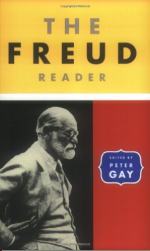|
This section contains 413 words (approx. 2 pages at 400 words per page) |

|
The Freud Reader Summary & Study Guide Description
The Freud Reader Summary & Study Guide includes comprehensive information and analysis to help you understand the book. This study guide contains the following sections:
This detailed literature summary also contains Topics for Discussion and a Free Quiz on The Freud Reader by Sigmund Freud.
This is an impressive assemblage and summary of Sigmund Freud's work in psychology. He is on the side of science during an era where science and theology were often in conflict so severe that they could not effectively function together. One of the great advances for twentieth and twenty-first century humanity is that these two are reconciled much more of the time without science having been reduced to a mockery of itself by religion.
Sigmund Freud is now recognized as being one of the most highly valued individuals in the development of psychology. During this era, psychology has been moving from being at the very earliest stages of development as a science into a field that has more to go on, more grounding, better research methods, more effective and extensive therapeutic techniques. Freud did something that at the time was viewed as drastic. At this point in history, his work is considered to be an incredibly valuable contribution: he introduced the idea that traumas related to some kind of sexual assault or abuse could be deciphered and that the problems that resulted could be treated - people who had suffered such things could actually be helped and disclosure could be done either directly or through the use of symptoms. He showed that hysteria was not strictly limited to women, even though the whole psychology of it was different. He began to make some effort to differentiate between the psychologies of women from men in an effort to create a more accurate framework for understanding and treating women. He argued that homosexuality was a rather natural, if limited orientation. He claimed that all humans have a bisexual element to them, rooted in prepubescent orientations towards parents and siblings. He introduced the idea of child psychology and pre-pubescent nascent sexuality in children even in terms of their self-orientations and orientation towards the world. He also was willing to include women in the field on a professional basis. This is exemplified in two extended activities: one is that he nurtured his daughter Anna's efforts to become a psychoanalyst in her own right - it worked. The other is that he and other women relatives included Louise Andreas-Salome, often known as Lou. While this Lou somehow never had an overt and clear career, she was a renowned intellectual of her era. The book covers in much greater detail these strides forward in the development of psychology as a real science through its chapters.
Read more from the Study Guide
|
This section contains 413 words (approx. 2 pages at 400 words per page) |

|



